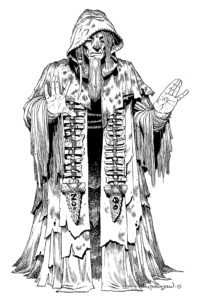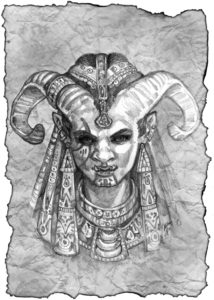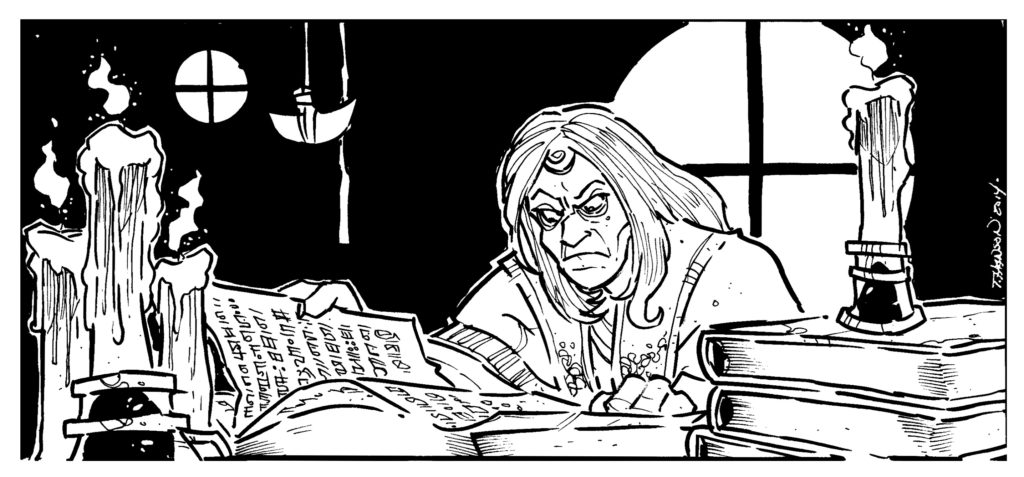Once you start playing your Earthdawn character, you start earning Legend Points. These are spent to advance talent and skill ranks, increase Attribute values, bond magic items, and other stuff.
Our Legends of Earthdawn campaign has been running for a while now. I thought it might be interesting — after walking through the build process — to show where Virag, my troll Nethermancer, currently stands and why I made the choices I did. I’m not going to go step-by-step through each phase of advancement, just run through her current sheet and explain why I made some of the choices I did.
As of this writing, Virag has 39,900 total Legend Points (and has spent all of them).
Attributes
I’ve spent points to raise two different Attributes, each by one point. Willpower was raised from 15 to 16, increasing it to Step 7 and boosting the effect of all Virag’s spells. Toughness was raised from 14 to 15, granting a couple extra points of Death and Unconsciousness Ratings, but more significantly increasing her Wound Threshold to 10.
Talents
Virag reached Fifth Circle with her latest stretch of downtime. All of her First through Fourth Circle Discipline talents are at Rank 5, except for Spellcasting and Nethermancy, which are both Rank 6. I hope I don’t need to explain why.
Summon, the Fifth Circle Discipline talent, is only at Rank 4 for now. I would have liked to get it higher, but there were other places I wanted to spend my points. Even when you have about 40k Legend, there’s always more you want than you can afford.
For optional talents I took Dispel Magic at Second Circle, and Suppress Curse at Third. These are broadly useful talents, and worth picking up since we don’t have a Wizard or Weaponsmith in the group to provide them. They also let me play a little bit in the Wizard space I was originally looking at for the character. Dispel Magic is currently Rank 4, Suppress Curse at Rank 3.
At Fourth Circle I picked up Command Nightflyer, mostly because I wanted to be able to play with the spells that interact with that talent (Dark Messenger, Dark Spy, Nightflyer’s Cloak). It’s currently at Rank 3.
In what should come as a surprise to nobody, my Fifth Circle optional talent is Enhanced Matrix. Combined with her free matrices and the optional Standard Matrix at First Circle, Virag has four innate spell matrices (two Standard, two Enhanced). All of her innate matrices are currently Rank 5.
Talent Knacks
I really like the Spellcasting knacks we introduced in the Earthdawn Companion, and Virag has learned three. Astral Strain (reduces the target’s Mystic Defense by 2), Bleed (reduces target’s Wound Threshold by 2), and Unsettle (target reduces Willpower-based tests by 2).
Spells
A lot of my Legend Points (and a not insignificant portion of my cash) has been sunk into learning spells. Virag has learned:
- First Circle: Bone Circle, Dark Messenger, Soulless Eyes, Spirit Grip
- Second Circle: Chilling Circle, Death’s Head, Night’s Edge, Shadow’s Whisper, Shield Mist, Summon Fog Ghost
- Third Circle: Arrow of Night, Aspect of the Bone Spirit, Fog of Fear, Grave Message, Pain, Palinthrax’s Siphon*, Summon Bone Spirit
- Fourth Circle: Dark Spy, Evil Eye, Last Chance, Nightflyer’s Cloak, Viewpoint
- Fifth Circle: Blind, Dust to Dust, Wither Limb
Palinthrax’s Siphon is a spell created for the game that ties in to plot stuff that has not yet been released in the podcast.
Skills
I’ve picked up a couple of skill ranks as well. While they aren’t as easy to advance as talents, the limits of optional talents mean there might be useful abilities you want but can’t fit into your talent progression.
I learned Avoid Blow at Rank 1, in part to help make Shield Mist more effective. I learned Awareness at Rank 1 to give me 2d6 on my general Perception tests (this was a very recent acquisition). I also increased my Read and Write Language skill to Rank 2 so that I could learn to read and write Theran (again, for story reasons not revealed in the podcast yet).
All three of those are available as talent options to Nethermancers, but that means I can’t use that optional slot for a talent like Dispel Magic or Command Nightflyer. I could potentially use them as options in my Journeyman tier… but that ties up slots better used for my newly available talent options. It also means that I either delay getting my additional Enhanced Matrix, or wait even longer to put one of those options at Sixth Circle (or higher).
Since advancement slows once you reach Journeyman Circles, that could be a long wait.
Thread Items
Virag has acquired two thread items in the game. The first is a Thorn Wand, woven up to Rank 4, providing an additional Standard Matrix, +1 rank to Spellcasting, +1 to Thread Weaving tests, and +1 rank Willforce.
The other item is just a Standard Matrix item, currently woven to Rank 3. But this means that, along with the matrix in the Thorn Wand, Virag has a total of 6 spell matrices:
- Standard Matrix (Free) at Rank 5
- Standard Matrix (Optional) at Rank 5
- Enhanced Matrix (Free) at Rank 5
- Enhanced Matrix (Optional) at Rank 5
- Standard Matrix (Thorn Wand) at Rank 4
- Standard Matrix (Matrix Item) at Rank 3
Even with that broad selection of matrices, though, spell selection can still be tough. I’m thinking that one of the Enhanced Matrices will hold either Astral Spear or an extra-thread Spirit Dart for damage. The other will probably hold Last Chance so that I have a better chance of bringing somebody back from the brink — trying to reattune on the fly, then thread and cast within the effective time limit of the spell is not fun. The other spell I’m inclined to keep handy is Shield Mist (for defense).
The other slots are a bit more flexible. Pain, Blind, or Dust to Dust would be useful depending on whether I’m expecting to go up against undead or Namegivers. Life Circle of One is another decent anti-undead spell, whereas Death’s Head is good against Namegivers as it lets me bring Frighten’s debuff power to bear more effectively. Arrow of Night or Night’s Edge are good buff spells, though I’m more likely to use the former (our Illusionist typically buffs front-liners with Monstrous Mantle, while I hang back with the Scout).
So that’s where Virag stands right now. I’m happy with her development so far, and see plenty more room to grow.

 This bit of forethought becomes easier as you become more familiar with the game and the options available (especially to starting characters), but even if you’re new to the system and building your first hero, don’t be overly shackled to the process described in the book. If, at a later step, you find you want to go back and tweak something from earlier, go right ahead. The character isn’t done until you set out on that first adventure.
This bit of forethought becomes easier as you become more familiar with the game and the options available (especially to starting characters), but even if you’re new to the system and building your first hero, don’t be overly shackled to the process described in the book. If, at a later step, you find you want to go back and tweak something from earlier, go right ahead. The character isn’t done until you set out on that first adventure. (6) Assign Talent Ranks and Spells
(6) Assign Talent Ranks and Spells The podcast launched yesterday.
The podcast launched yesterday.  With all that theory-crafting in mind, here’s how I decided to spend my Attribute build points.
With all that theory-crafting in mind, here’s how I decided to spend my Attribute build points.